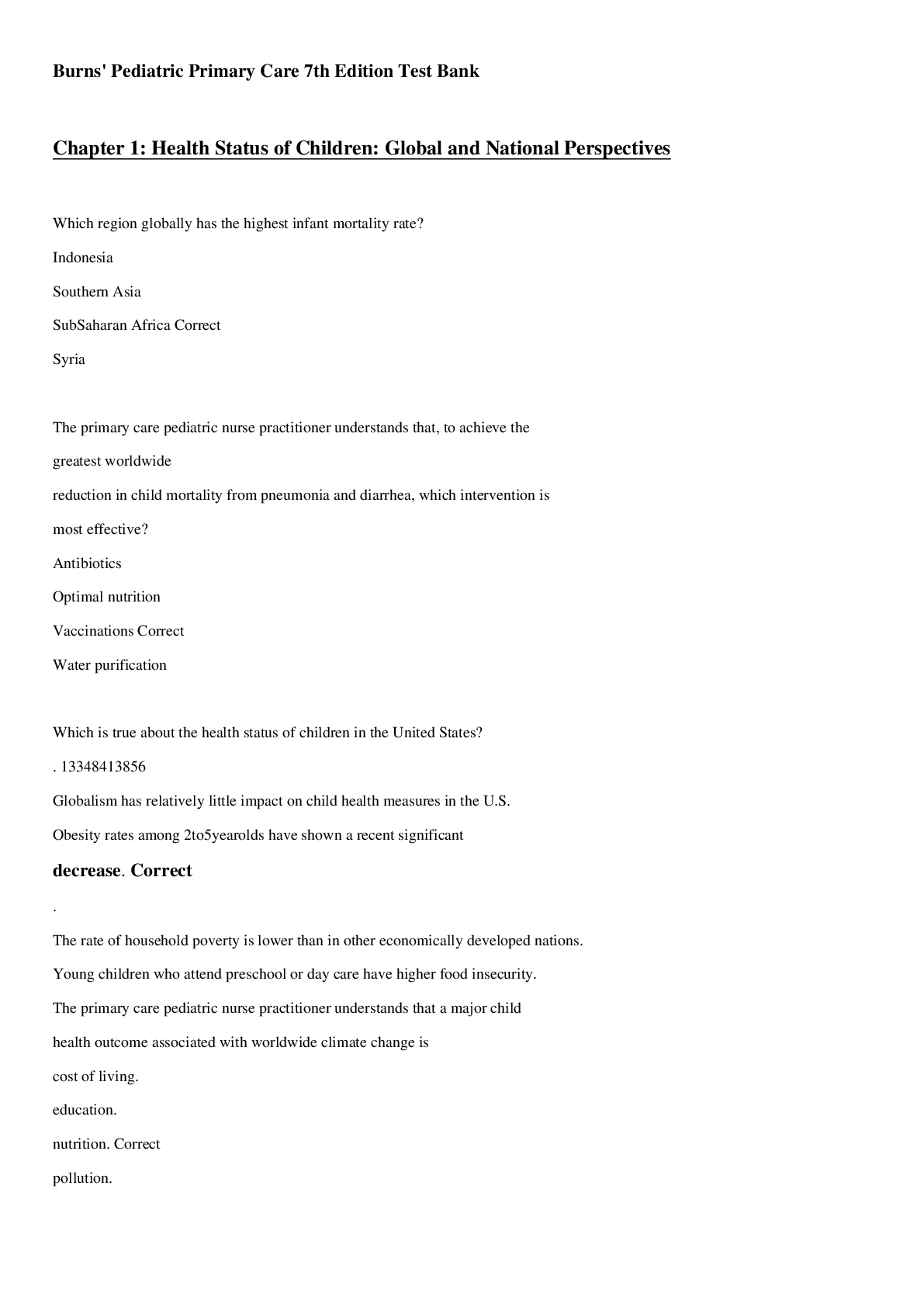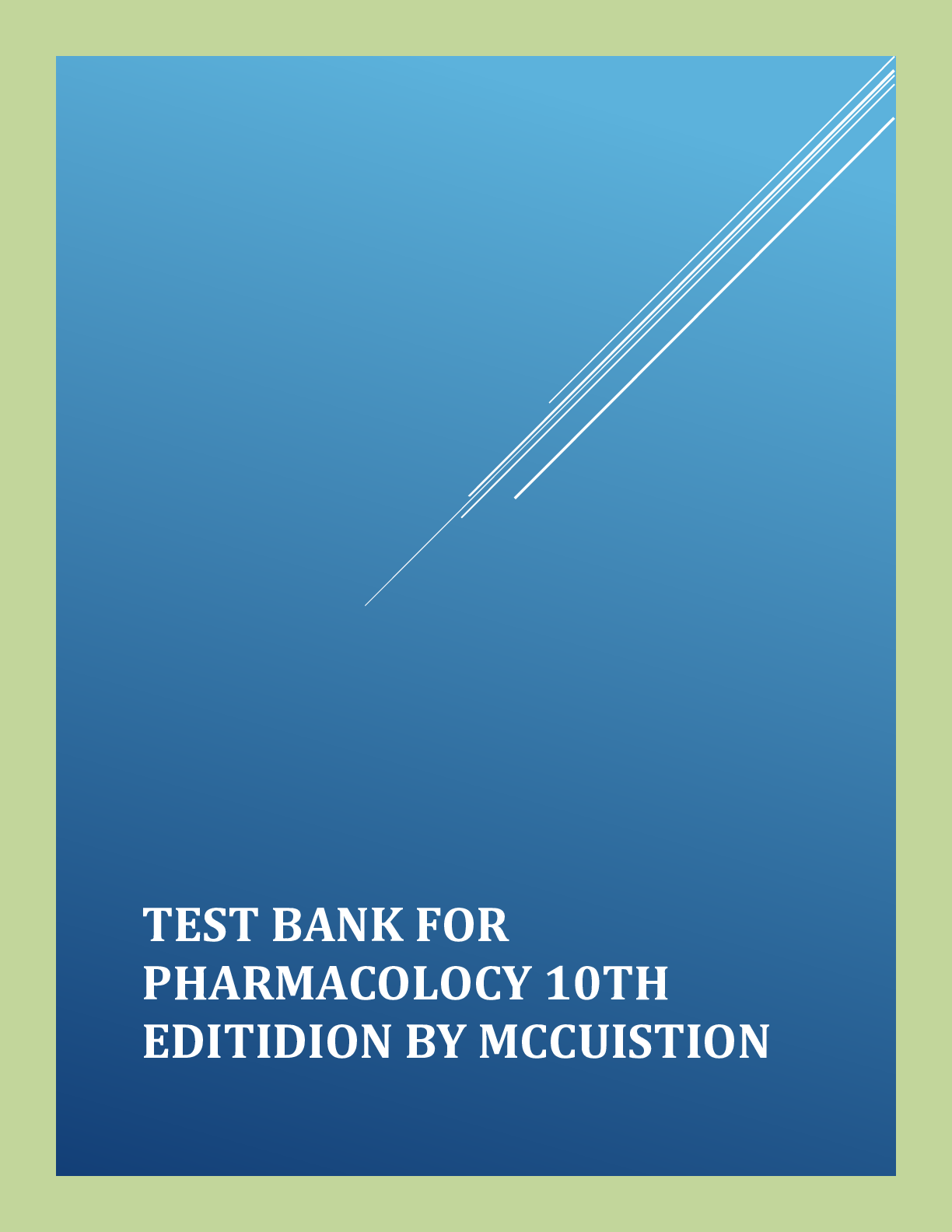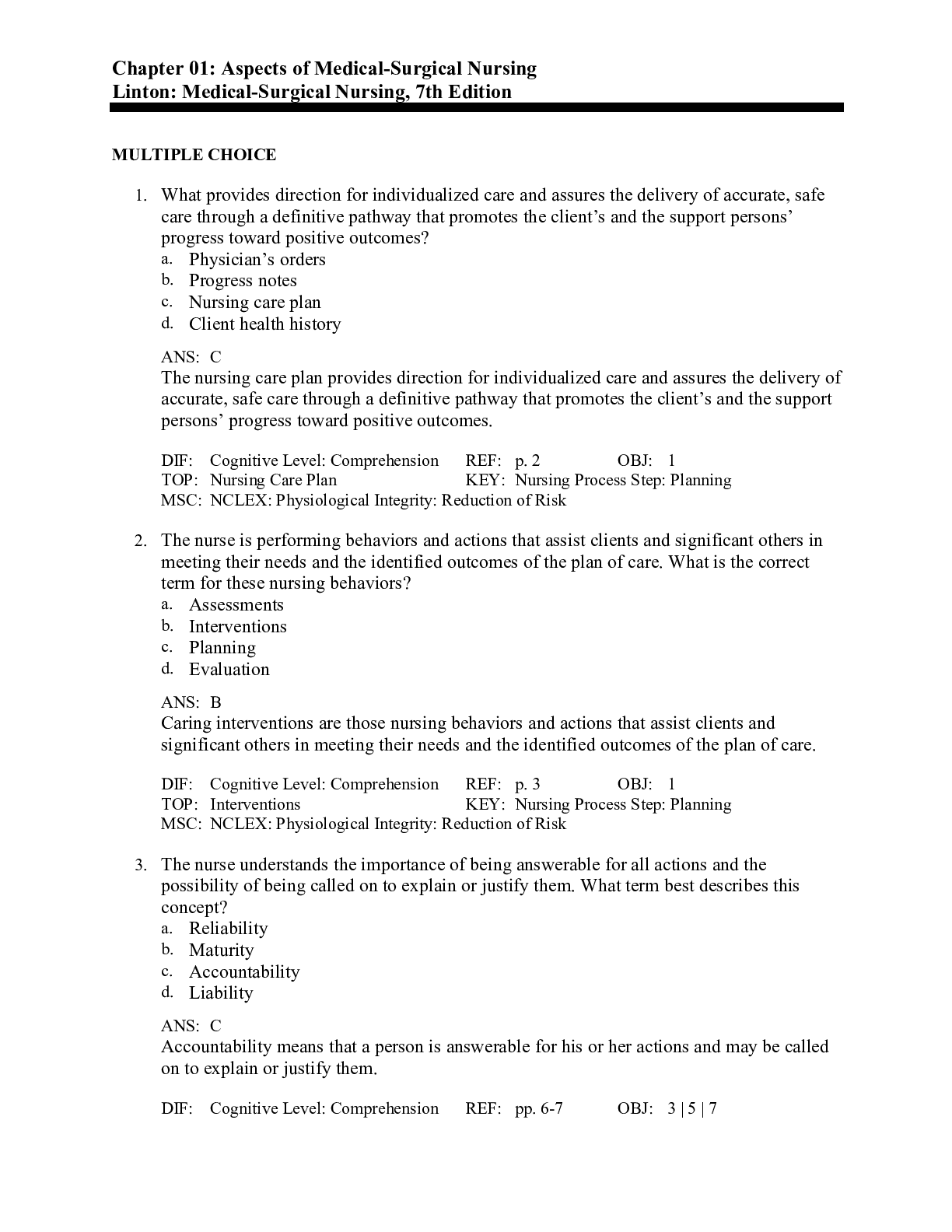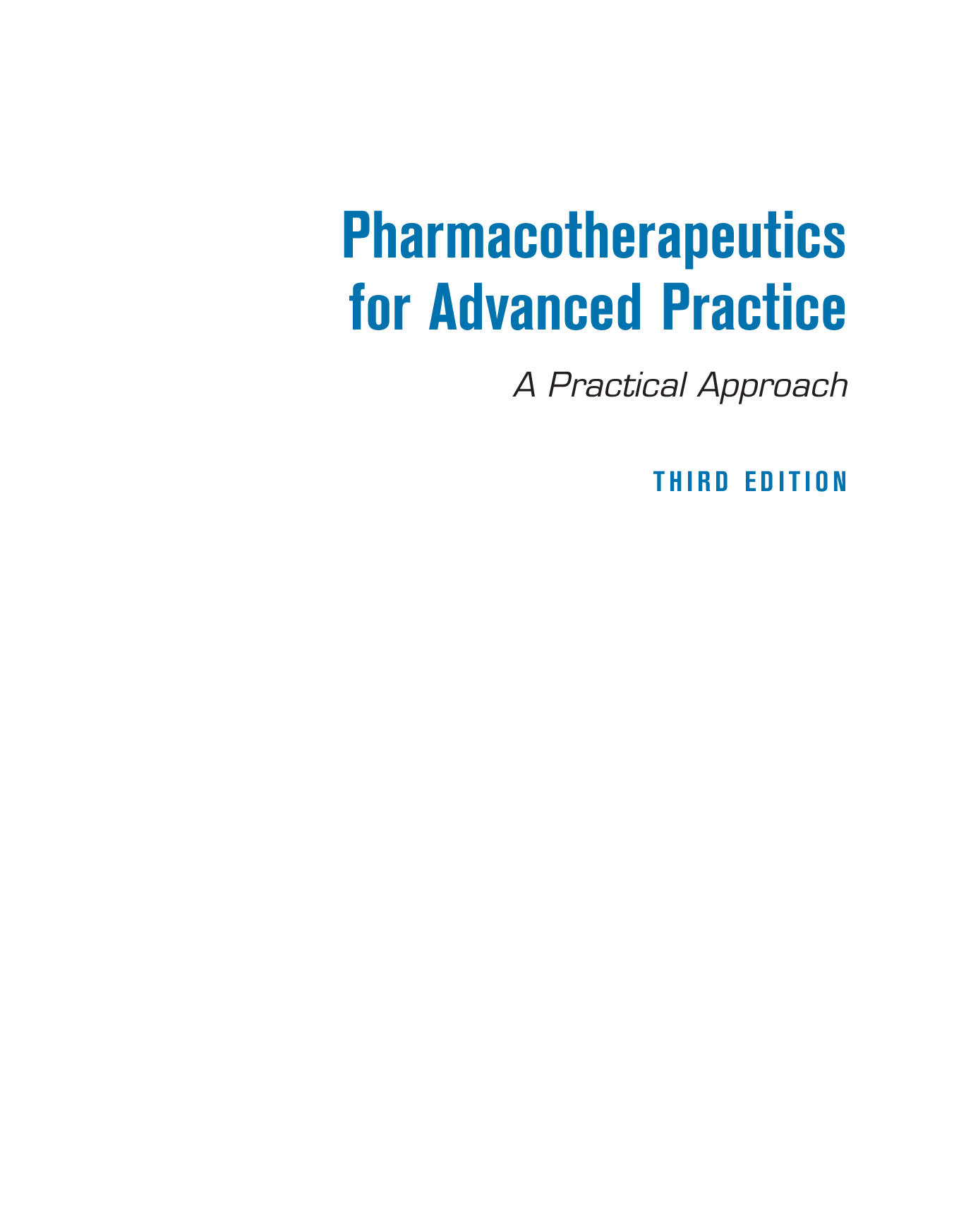*NURSING > TEST BANKS > Pharmacotherapeutics for Advanced Practice 3rd edition. (All)
Pharmacotherapeutics for Advanced Practice 3rd edition.
Document Content and Description Below
Pharmacotherapeutics for Advanced Practice A Practical Approach THIRD EDITION Arcangelo_FM.indd i 10/8/2011 2:55:28 PM Arcangelo_FM.indd ii 10/8/2011 2:55:28 PM Pharmacotherapeutics for Advanced Pract... ice A Practical Approach THIRD EDITION Editors VIRGINIA POOLE ARCANGELO, PhD, CRNP Family Nurse Practitioner Avocare Gigliotti Family Medicine Berlin, New Jersey ANDREW M. PETERSON, PharmD, PhD Dean, Mayes College of Healthcare Business and Policy Associate Professor of Clinical Pharmacy and Health Policy University of Sciences in Philadelphia Philadelphia, Pennsylvania Arcangelo_FM.indd iii 10/8/2011 2:55:28 PM Acquisitions Editor Bill Lamsback Product Director David Moreau Product Manager Rosanne Hallowell Copy Editor Amy Furman Proofreader Christine Dahlin Editorial Assistants Karen J. Kirk, Jeri O’Shea, Linda K. Ruhf Creative Director Doug Smock Cover Designer David Levy Vendor Managers Beth Martz and Karyn Crislip Manufacturing Manager Beth J. Welsh Production and Indexing Services SPi Global The clinical treatments described and recommended in this publication are based on research and consultation with nursing, medical, and legal authorities. To the best of our knowledge, these procedures reflect currently accepted practice. Nevertheless, they can’t be considered absolute and universal recommendations. For individual applications, all recommendations must be considered in light of the patient’s clinical condition and, before administration of new or infrequently used drugs, in light of the latest package-insert information. The authors and publisher disclaim any responsibility for any adverse effects resulting from the suggested procedures, from any undetected errors, or from the reader’s misunderstanding of the text. © 2013 by Lippincott Williams & Wilkins. © 2006 and 2001 by Lippincott Williams & Wilkins. All rights reserved. This book is protected by copyright. No part of it may be reproduced, stored in a retrieval system, or transmitted, in any form or by any means—electronic, mechanical, photocopy, recording, or otherwise—without prior written permission of the publisher, except for brief quotations embodied in critical articles and reviews, and testing and evaluation materials provided by the publisher to instructors whose schools have adopted its accompanying textbook. For information, write Lippincott Williams & Wilkins, 323 Norristown Road, Suite 200, Ambler, PA 19002-2756. Printed in China PAP3E010112 Library of Congress Cataloging-in-Publication Data Pharmacotherapeutics for advanced practice: a practical approach / [edited by] Andrew M. Peterson, Virginia Poole Arcangelo. — 3rd ed. p. ; cm. Includes bibliographical references and index. ISBN 978-1-4511-1197-2 (pbk.) 1. Chemotherapy. I. Peterson, Andrew M. II. Arcangelo, Virginia Poole. [DNLM: 1. Drug Therapy—methods. 2. Pharmaceutical Preparations—administration & dosage. WB 330] RM262.P4685 2011 615.5¢8—dc22 2011012201 Arcangelo_FM.indd iv 10/8/2011 2:55:32 PM This book is in memory of Tony. Without your love and support, this book would never have happened. You will always be remembered and will live in our hearts forever. Death leaves a heartache no one can heal, love leaves a memory no one can steal. —From a headstone in Ireland Arcangelo_FM.indd v 10/8/2011 2:55:32 PM Arcangelo_FM.indd vi 10/8/2011 2:55:32 PM P REFAC E harmacotherapeutics for Advanced Practice originated from our combined experience in teaching nurse practitioners. As a nurse practitioner and educator herself, Virginia saw a need for practical exposure to the general principles of prescribing and monitoring drug therapy, particularly in the Family Practice arena. As a PharmD, Andrew saw a need to be able to teach new prescribers how to think about prescribing systematically, regardless of the disease state. We both found no suitable book that combined the practical with the systematic—most of the textbooks dedicated to this topic provided too much basic pharmacology with too little therapeutics. This book not only gives the basics on the pharmacology of the drugs, it also provides a process through which learners can begin to think pharmacotherapeutically—that is, learners will begin to identify a disease, review the drugs used to treat the disease, select treatment based on goals of therapy and special patient considerations, and learn how to adjust therapy if it fails to meet goals. This is a book that meets the needs of both students and practitioners in a practical approach that is user friendly. It teaches the practitioner how to prescribe and manage drug therapy in primary care. The design of the book is based on input from both academicians and practitioners. Contributors were selected from academia and practice to provide a combination of evidence-based medicine and practical experience. The text considers disease- and patient-specific information. With each chapter, there are tables and algorithms that are practical and easy to read and that complement the text. Additionally, the text guides the practitioner to a choice of second- and third-line therapy when the first line of therapy fails. Since new drugs are being marketed at all times, drug categories are discussed and information can be applied to the new drugs. Each chapter ends with a simple case study designed to prompt the learner to think and the teacher to ask critical questions. Also, each case study asks the same questions, reinforcing a clinical decision-making process. There are no answers to the questions since the authors believe the purpose of the case studies is to promote discussion, and that there may be more than one correct answer to each question, especially as new drugs are developed. What’s more, the questions appear in the order in which they would be asked by a practitioner as he or she prescribes a medication. P ORGANIZATION OF THE BOOK Unit 1—Principles of Therapeutics The first chapter introduces the prescribing process, including how to avoid medication errors. The next chapter provides the traditional, and necessary, information on the pharmacokinetics and pharmacodynamics of drugs. Using this foundation, the subsequent chapters apply this information to drug–drug and drug–food interactions, and discuss the changes in these parameters in pediatric, geriatric, and pregnant patients. The remaining chapters in the Principles unit give overviews of drugs that are used across many disease states: pain medications and antibiotics. These chapters discuss the principles of pain management and infectious disease therapy, so that the reader can learn how these concepts are applied to the disorders discussed in the following units. A full chapter on Complementary and Alternative Medicine (CAM) is included in this unit, recognizing continued use of these modalities and attempting to meet the ever-growing need for information related to this aspect of patient care. New to this unit is a full chapter on Pharmacogenomics—the study of the human genes, effect on drug behavior. The addition of this chapter reflects the rapidly growing need for the clinician to understand how small variations in a person’s genetic makeup can greatly affect how that person responds to drug therapy. While this chapter presents a general overview of this area of study, several of the disorders chapters incorporate this information directly into the clinical decision-making process. Units 2 through 12—Disorders This section of the book, consisting of 40 chapters, reviews commonly seen disorders in the primary care setting. Although not all-inclusive, the array of disorders allows the reader to gain an understanding of how to approach the pharmacotherapeutic treatment of any disorder. The chapters are designed to give a brief overview of the disease process, including the causes and pathophysiology, with an emphasis placed on how drug therapy can alter the pathologic state. Diagnostic Criteria and Goals of Therapy are discussed and underlie the basic principles of treating patients with drugs. The drug sections review the agents’ uses, mechanism of action, contraindications and drug interactions, adverse effects, and monitoring parameters. This discussion is organized primarily by drug class, with notation to specific drugs within the text and the tables. The tables provide the reader with quick access to generic and trade names and dosages, adverse events, contraindications, and special considerations. Used together, the text and tables provide the reader with sufficient information to begin to choose a drug therapy for a patient. The section on Selecting the Most Appropriate Agent aids the reader in deciding which agent to choose for a given patient. This section contains information on first-line, second-line, and third-line therapies, with rationales for why agents are classified in these categories. Accompanying this section is an algorithm vii Arcangelo_FM.indd vii 10/8/2011 2:55:32 PM viii PREFACE outlining the thought process by which clinicians select an initial drug therapy. Again, the text organization and the illustrative algorithms provide readers with a means of thinking through the process of selecting drugs for patients. In the third edition, we have kept the Recommended Order of Treatment tables and updated them, along with the algorithms and drug tables, to reflect current knowledge. Each chapter has been updated to reflect the most current guidelines available at the time of writing. However, medicine and pharmacotherapy are constantly changing, and it remains the clinician’s responsibility to determine the most current information. Included in each chapter is a section on monitoring a patient’s response. This encompasses clinical and laboratory parameters, times when these items should be monitored, and actions to take in case the parameters do not meet the specified goals of therapy. In addition, special patient populations are discussed when appropriate. These discussions include pediatric and geriatric patients, but may also include ethnic- or sexrelated considerations. Last, this section includes a discussion of patient education material relevant to the disease and drugs chosen. In each chapter there is a patient education section that includes information on CAM related to that disorder as well as sections on external information for patients and practitioners. Each of the case studies has been reviewed and updated as appropriate. However, the pedagogical style of reasoning remains the same. Answers to these case studies are not supplied since the purpose is to promote discussion and evoke a thought process. Also, as time changes, so do therapies. The cases are short, compelling the learner to ask questions about the patient and allowing flexibility for multiple “right” answers to be developed by the instructor as they work through the clinical decision-making process. Unit 13—Pharmacotherapy in Health Promotion This unit discusses several areas of interest for promoting health or maintaining a healthy lifestyle using medications, including smoking cessation, immunizations, weight management, and contraception. A new chapter to this section is Travel Medicine. This is a growing area, and we felt readers of this text need to have an understanding of the complexity of world travel and how it affects pharmacotherapy. Unit 14—Women’s Health This is a new unit in the third edition. We felt that there is a growing emphasis on Women’s Health and that compiling the chapters relevant to this area of study would assist the learner in recognizing the special nature of care that this population deserves. Unit 15—Integrative Approach to Patient Care While there are only two chapters in this unit, they represent the culmination of the text. Practitioners need to have an understanding of the economics of pharmacotherapeutics in order to effectively prescribe medications and treat patients. Arcangelo_FM.indd viii With the ever-increasing costs of pharmaceuticals and the introduction of far-sweeping legislation, such as Medicare Part D, the practitioner needs to be fully aware of the systems in place that facilitate, or hinder, a patient’s access to medications. This chapter discusses the economics of therapeutics, including formularies, co-pays, prior authorizations, and Medicare as well as managed care as it applies to prescribing medications. The last chapter, Integrative Approaches to Pharmacotherapy, is an attempt to examine real-life, complex cases. Each case addresses the nine questions posed in the individual chapter case studies, but now provides the reader with examples of how to approach the case studies and examines issues to consider when presented with more than one diagnosis. These cases are more complex, requiring the reader to think through multiple diseases and therapies instead of a single disorder in isolation. Within this chapter we do offer potential answers to the cases. These may not be the only answers, but indicate some of the thought processes that go into the decision-making process in the pharmacologic management of a problem. Chapter Organization The book offers a consistent approach throughout each disorder chapter. The chapter format begins with the background and pathophysiology of the disorder, followed by a discussion of the relevant classes of drugs. These broad categories are then integrated in the section on Selecting the Most Appropriate Agent. Drug overview tables are also organized consistently, giving the reader much information on each drug, including the usual dose, contraindications and side effects, and any special considerations a prescriber should be aware of during therapy. All of this information is supported by the significant text. Algorithms provide the reader with a visual cue on how to approach treating a patient. Recommended order of treatment tables provide the reader with basic drug therapy selection, from first-line to third-line therapies for each disorder. These, coupled with the algorithms and the drug tables, are the core of the text. A case study is provided for each disorder discussed. These short cases are designed to stimulate discussion among students and with instructors. The nine questions at the end of each case are tailored to each disorder, but remain similar across all cases to reinforce the process of thinking pharmacotherapeutically. Pharmacotherapeutics for Advanced Practice is intended to provide primary care students with a reasoned approach to learning pharmacotherapeutics and to serve as a reference for the seasoned practitioner. As experienced educators and practitioners, we are dedicated to providing you with a textbook that will meet your needs. Virginia Poole Arcangelo Andrew M. Peterson 10/8/2011 2:55:32 PM CO N T RI B UTOR S Angela A. Allerman, PharmD, BCPS Clinical Pharmacy Specialist Department of Defense Pharmacoeconomic Center Fort Sam Houston, TX Chapter 49: Anticoagulation Disturbances Kelly Barranger, MSN, RN, CRNP Department of Veteran’s Affairs Philadelphia, PA Chapter 19: Hypertension Chapter 50: Anemias Anemias John Barron, BS Pharmacy, PharmD Executive Director Health Plan Research HealthCore, Inc. Wilmington, DE Chapter 20: Hyperlipidemia Laura L. Bio, PharmD, BCPS Assistant Professor in Clinical Pharmacy, Pediatrics Department of Pharmacy Practice and Pharmacy Administration University of the Sciences Philadelphia, PA Clinical Pediatric Pharmacy Specialist Department of Pharmacy Cooper University Hospital Camden, NJ Chapter 18: Otitis Media and Otitis Externa Tim A. Briscoe, PharmD, CDE Clinical Pharmacist Specialist Columbus Regional Health System Columbus, GA Chapter 3: Impact of Drug Interactions and Adverse Events on Therapeutics Debra Carroll, MSN, CRNP Gerontological Nurse Practitioner Tri-Valley Primary Care Telford, PA Chapter 6: Principles of Pharmacotherapy in Elderly Patients Quinn A. Czosnowski, PharmD, BCPS Assistant Professor of Clinical Pharmacy Pharmacy Practice and Pharmacy Administration Philadelphia College of Pharmacy University of the Sciences Philadelphia, PA Clinical Pharmacist, Intensive Care Unit Cooper University Hospital Camden, NJ Chapter 39: Seizure Disorders Lauren M. Czosnowski, PharmD, BCPS Assistant Professor of Clinical Pharmacy Department of Pharmacy Practice/Pharmacy Administration Philadelphia College of Pharmacy University of the Sciences Internal Medicine Clinical Specialist Pharmacy Hospital of the University of Pennsylvania Philadelphia, PA Chapter 47: Allergies and Allergic Reactions Elyse L. Dishler, MD Karen S. Harkaway Dermatology Delran, NJ Chapter 38: Headaches Amy M. Egras, PharmD, BCPS Assistant Professor Department of Pharmacy Practice Thomas Jefferson University, Jefferson School of Pharmacy Clinical Pharmacist Jefferson Family Medicine Associates Thomas Jefferson University Hospital Philadelphia, PA Chapter 54: Weight Loss Heather E. Fean, MSN, APN-C Nurse Practitioner Advocare Gigliotti Family Medicine Berlin, NJ Chapter 22: Heart Failure Kelleen N. Flaherty, MS Assistant Professor Biomedical Writing University of the Sciences in Philadelphia Philadelphia, PA Chapter 38: Headaches ix Arcangelo_FM.indd ix 10/8/2011 2:55:33 PM x CONTRIBUTORS Maria Foy, PharmD, CPE Clinical Coordinator, Pharmacy Department Abington Memorial Hospital Abington, PA Chapter 7: Principles of Pharmacology in Pain Management Chapter 14: Bacterial Infections of the Skin Stephanie A. Gaber, PharmD, CDE Clinical Coordinator Department of Pharmacy Thomas Jefferson University Hospital—Methodist Division Philadelphia, PA Chapter 5: Principles of Pharmacotherapy in Pregnancy and Lactation Jomy M. George, PharmD, BCPS Assistant Professor in Clinical Pharmacy Department of Pharmacy Practice and Pharmacy Administration University of the Sciences Philadelphia, PA Clinical Pharmacist—Infectious Disease/HIV Department of Pharmacy Cooper University Hospital Camden, NJ Chapter 18: Otitis Media and Otitis Externa Ellen Boxer Goldfarb, CRNP Outpatient Coordinator Jefferson Antithrombic Services Thomas Jefferson Internal Medicine Associates Philadelphia, PA Chapter 49: Anticoagulation Disturbances Andrew J. Grimone, PharmD, RPh, BCPS Assistant Professor Department of Nursing Clarion University of Pennsylvania Oil City, PA Clinical Pharmacy Manager Department of Pharmacy Saint Vincent Health Center Erie, PA Chapter 8: Principles of Antimicrobial Therapy Emily R. Hajjar, PharmD, BCPS, CGP Associate Professor Jefferson School of Pharmacy Thomas Jefferson University Philadelphia, PA Chapter 44: Alzheimer’s Disease Andrea M. Heise, MSN, APN-C Nurse Practitioner Advocare Gigliotti Family Medicine Berlin, NJ Chapter 22: Heart Failure Arcangelo_FM.indd x Lauren K. McCluggage, PharmD, BCPS Assistant Professor Department of Pharmacy Practice and Pharmacy Administration Philadelphia College of Pharmacy, University of the Sciences Clinical Pharmacy Specialist—Internal Medicine Department of Pharmacy Hospital of the University of Pennsylvania Philadelphia, PA Chapter 36: Osteoarthritis and Rheumatoid Arthritis Carol Gullo Mest, PhD, RN, ANP-BC Associate Professor Director of Graduate Nursing Programs DeSales University Center Valley, PA Chapter 36: Osteoarthritis and Rheumatoid Arthritis Samir K. Mistry, PharmD Corporate Vice President of Pharmacy Aveta, Inc. Fort Lee, NJ Chapter 59: The Economics of Pharmacotherapeutics Angela Cafiero Moroney, PharmD Senior Clinical Science Manager Global Pharmaceutical Research and Development Abbott Laboratories Abbott Park, IL Chapter 44: Alzheimer’s Disease Betty E. Naimoli, MSN, CRNP Adjunct Professor Frances M. Maguire School of Nursing Gwynedd-Mercy College Gwynedd Valley, PA Nurse Practitioner Health Physicians Network Abington Memorial Hospital Abington, PA Chapter 37: Fibromyalgia Jessica O’Hara, PharmD Medical Writer Aston, PA Chapter 54: Weight Loss Dharmi Patel, PharmD Clinical Pharmacist Home Solutions Horsham, PA Chapter 43: Attention-Deficit/Hyperactivity Disorder Jeegisha ... [Show More]
Last updated: 2 years ago
Preview 1 out of 68 pages
.png)
Buy this document to get the full access instantly
Instant Download Access after purchase
Buy NowInstant download
We Accept:

Reviews( 0 )
$20.00
Can't find what you want? Try our AI powered Search
Document information
Connected school, study & course
About the document
Uploaded On
Apr 21, 2021
Number of pages
68
Written in
Additional information
This document has been written for:
Uploaded
Apr 21, 2021
Downloads
0
Views
114













.png)
_compressed.png)


